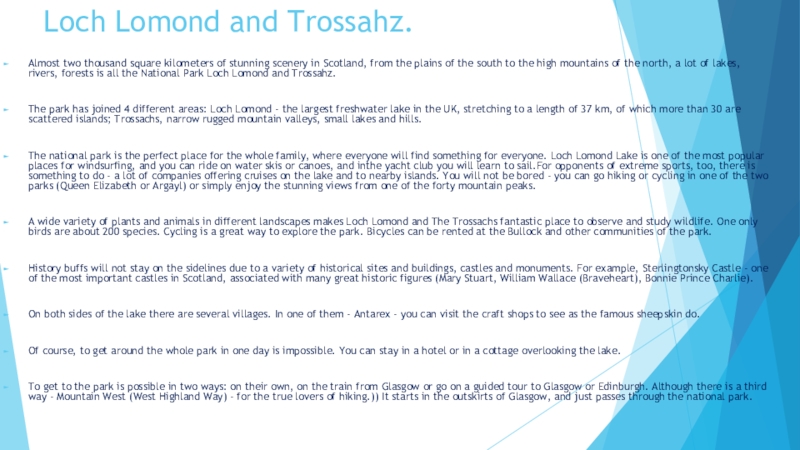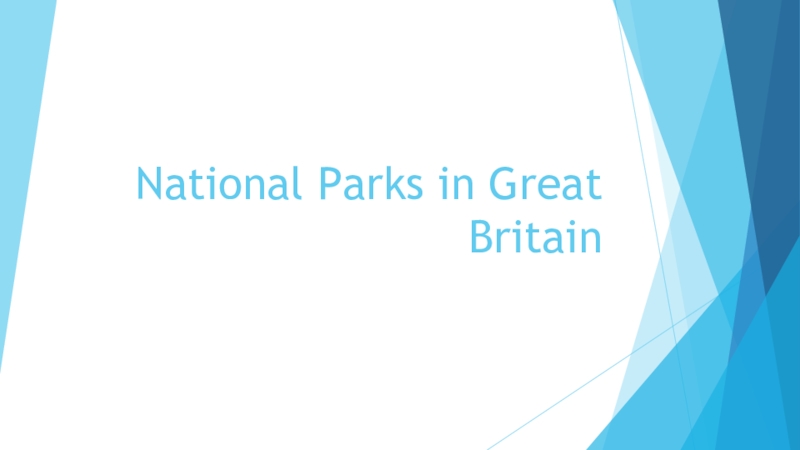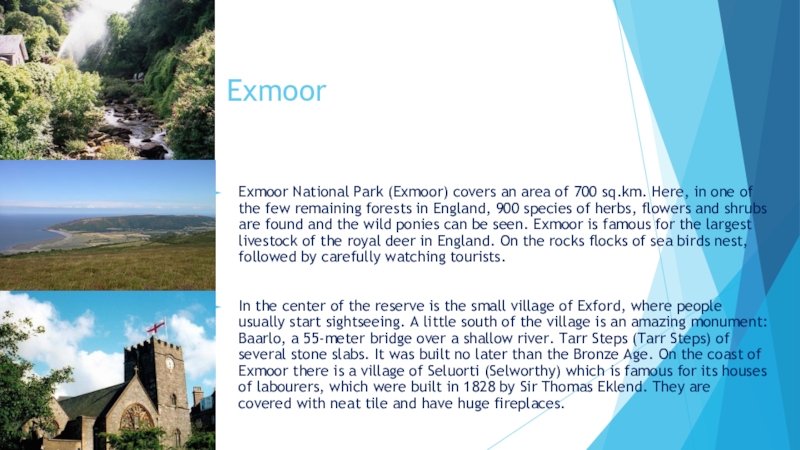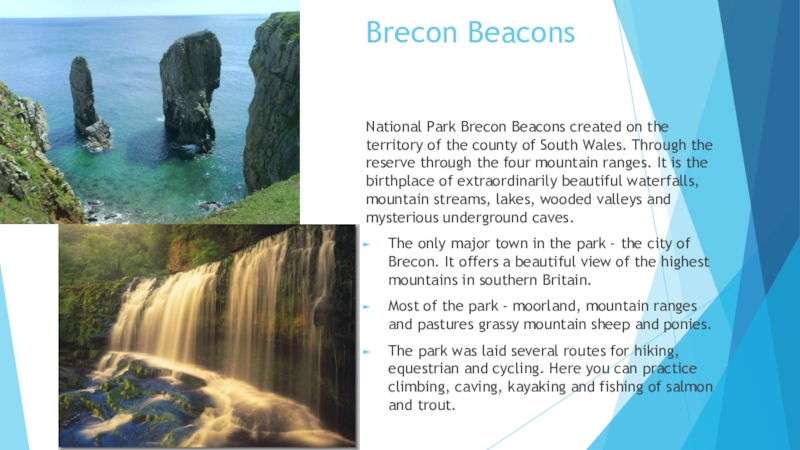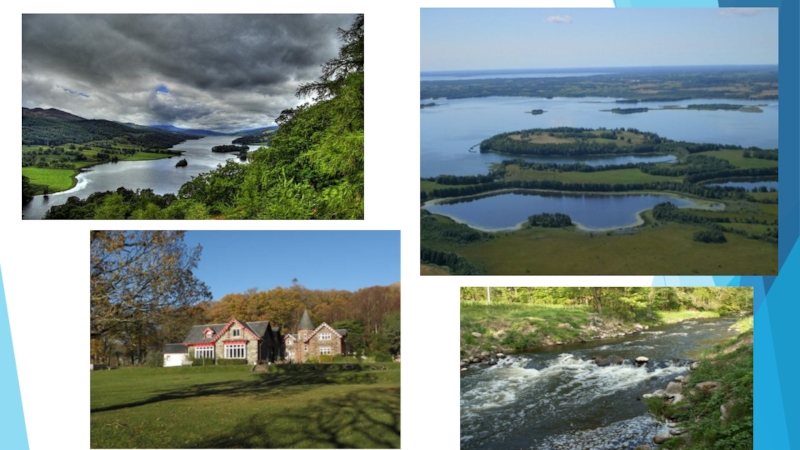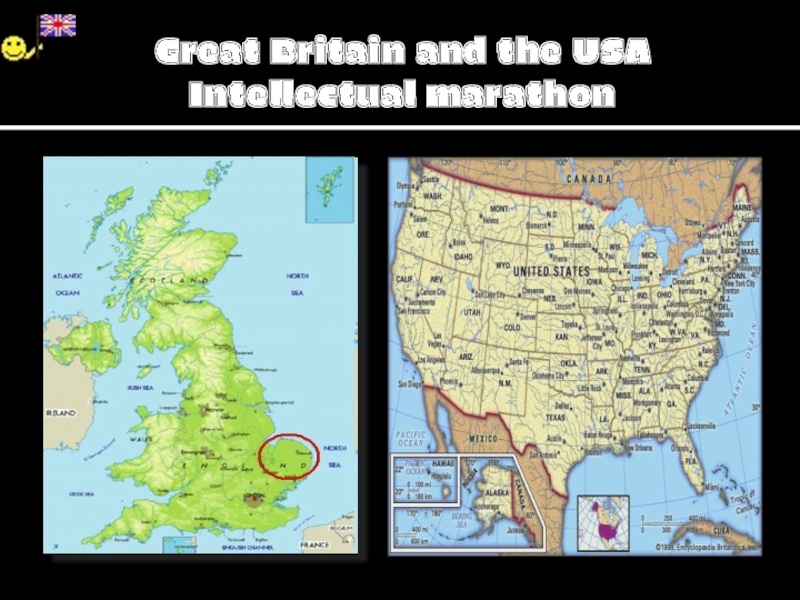Слайд 1National Parks in Great Britain
Слайд 2Dartmoor
England’s Dartmoor National Park stretches over four hundred and eighty
kilometers, it is located to the north-east of the town.
Its rocky peaks, valleys and desolate wastelands very of great interest for tourists. The main attraction of the granite massifs area over thousands of kilometers can be called TORZ - a stone tower resembling giant sculptures. In the mountain swamp as in the sponge, rain water accumulates, it implies several streams, running to shore. This National Park is often visited by biologists and botanists, interested in peat moss, marsh grasses, heather and reeds. Among the rocks it is often possible to see the wild ponies, cows and white sheep.
Dartmoor is famous for the fact that in its territory there are many prehistoric stone circles and dolmens. Archaeologists have found here a lot of evidence about the life of people in ancient times - a prehistoric park, sanctuary, roads and Neolithic settlements. River Dartmoor transferred ancient bridges hewn from granite slabs; in caves near the town of Torquay researchers have found the most ancient traces of primitive people. Many archaeological sites and archaeological finds are directly related to the period between the two-thousand and five hundred years BC. Here, scientists have discovered more than two thousand ancient sacred stone circles. Due to the fact that the soil of Dartmoor has a specific acidity, metal work and human remains are very rare.
After the Romans had conquered Britain, they founded the city of Exeter, Devon appeared in the VIII century. The Dartmoor area was constantly exposed to attacks of the Scandinavian Vikings and the Danes. After the Norman invasion in 1066 English feudal castles were built, around which the city gradually began to grow.
The Middle Ages were marked by the fact that in the swamps of Dartmoor artisanal began to extract silver, iron ore, tin, manganese, copper. At the beginning of the XIXth century the ports of Dartmoor exported tin mined in Dartmoor and fabrics that were made.
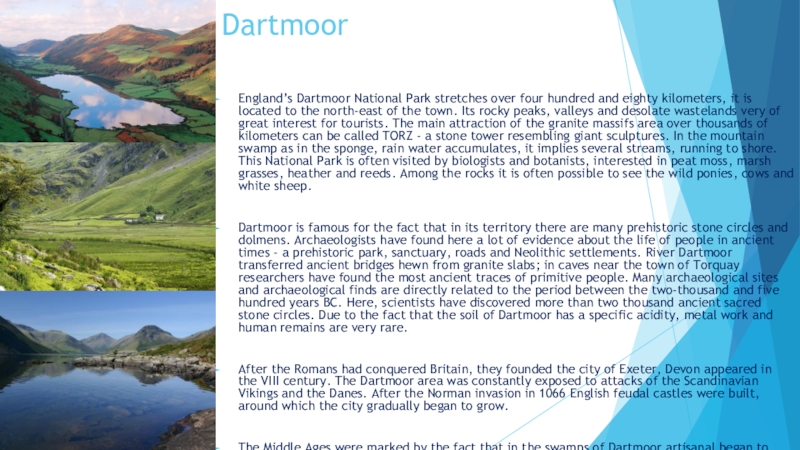
Слайд 3Exmoor
Exmoor National Park (Exmoor) covers an area of 700 sq.km.
Here, in one of the few remaining forests in England,
900 species of herbs, flowers and shrubs are found and the wild ponies can be seen. Exmoor is famous for the largest livestock of the royal deer in England. On the rocks flocks of sea birds nest, followed by carefully watching tourists.
In the center of the reserve is the small village of Exford, where people usually start sightseeing. A little south of the village is an amazing monument: Baarlo, a 55-meter bridge over a shallow river. Tarr Steps (Tarr Steps) of several stone slabs. It was built no later than the Bronze Age. On the coast of Exmoor there is a village of Seluorti (Selworthy) which is famous for its houses of labourers, which were built in 1828 by Sir Thomas Eklend. They are covered with neat tile and have huge fireplaces.
Слайд 4New Forest
The National Park New Forest is located
in the south of England, between Southampton and Bournemouth on
the southern coast of the island. Most of it is included in Hampshire County, the rest is in Wiltshire.The entire territory of the present New Forest is covered with forests. However, the land is proved to be marginal, and the New Forest area has gradually turned into a landscape of forests, meadows and wasteland.
In 1079 the English king William I the Conqueror declared the area reserved the royal forest for deer hunting. For the first time the New Forest is mentioned (as Nova Foresta) in the Domesday Book (Census landed medieval England) in 1086. For centuries, the royal forests were suppliers to the Royal Navy. During the First and Second World Wars, when the demand for timber has been particularly high, after cutting deciduous trees in the New Forest conifers were planted. Currently, there is a reverse process.
Approximately 90% of the territory is owned by the British crown. At the same time, about 50% of all land holdings of the royal family in Britain is concentrated in the New Forest. The park is the village of Beaulieu is with the same aristocratic manor and a museum of racing cars.
In 1999 it was decided to set up a park on the territory of the New Forest National Park. In June 2004 its borders were defined. On 1 April 2005 the park was officially opened. Its territory covers an area of 571 square kilometers.
As a non-natural attractions can old noble mansion Bewley should be mentioned. The National Museum of engines (more than 300 vintage cars) and a small harbor town of Lymington are of interest.
In the park various species of the deer live: fallow deer, red deer, sika deer, the Chinese muntjac. Here - the birthplace of a special kind of pony - New Forest Pony ( a legend says, if they came from the Spanish horses that escaped the crash of the ships of the Armada in 1588). From other species reptiles should be noted. The park is inhabited by ordinary copperhead, grass snakes ,sand lizards, less well-known crested newt and others. Also in the park are many badgers, martens. No large predators, and therefore the deer feel more than safe.
For tourists who have decided to visit this beautiful area, there are 4 hotels. It Forest Lodge Hotel, Moorhill House Hotel, Beaulieu Hotel and Bartley Lodge Hotel.
To get an unforgettable experience and enjoy the nature of the park it is better to drive in a car and you may go cycling or walking to the park.
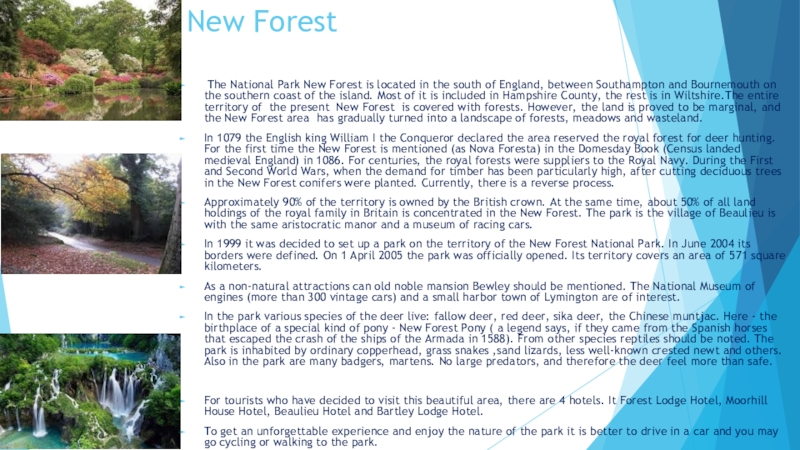
Слайд 5Yorkshire Dales
Yorkshire Dales is a National Park in the
historic county of Yorkshire in northern England, the edge of
the limestone hills. The hills give way to swamps and little wood in which lovers collect blueberries and lingonberries. North of the park known as Sveyldeyl (Swaledale) and is famous for the numerous ruins of old industrial plants. Area Wensleydale (Wensleydale) abounds in natural beauty, cliffs and waterfalls. Hardrou-Force falls from a height of 28 m. South Park is famous for the ruins of the monastery Bolton (Bolton, founded in 1155), which skirts the River Wharfe.
Richmond (Richmond) is the most important town in the Yorkshire Dales. The population is approx. 10 thousand inhabitants (1999). It grew up around the Norman castle in 1070. Its enormous walls and towers and now towering over the river of Swale. Medieval narrow streets diverge from the old fairgrounds, which has a market cross, a sign that the town has the right to bargain. Buildings town much younger street belongs to Georgian and Victorian style. The local Royal Theatre was founded in 1788 and is one of the oldest in the country. 2 km from Richmond there are the ruins of Easby Abbey (Easby), founded in the 12th century.
From Yorkshire Dales one can go on a trip to the secluded abbey ruins Faunteyns (Fountains). Poets and artists glorified romance its ruins as the most scenic in the country. The monastery, founded in the 12th century,was destroyed during the Reformation. In 1727 the abbey was laid out around the park Studley Royal (Studley Royal) with ponds, pavilions, statues and lakes.
Hayworth (Haworth), a town with a 10 thousand population, is famous as the birthplace of the Bronte family.
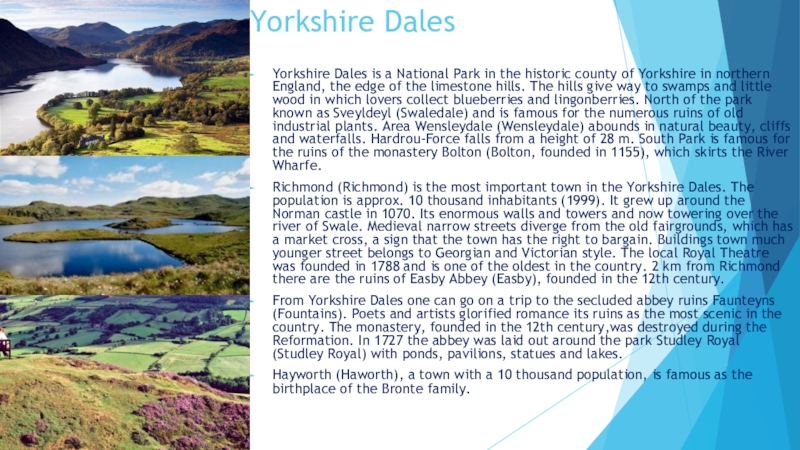
Слайд 6Snowdonia
Wherever you have moved, travelling around Wales - everything will
be worth seeing and be inspired by, so it will
be hard to stay disappointed. Yet there are places that stand apart in the lists of travellers. A special place in this list is northwest of the country and its jewel is the Snowdonia National Park.
The name of the park Snowdon was given to the park after the mountain peak, located in the centre of the massif, which occupies most of the park. Mount Snowdon, incidentally, is the highest in Wales (1085m). The slopes of Snowdon (as well as all other peaks in the park) are very harsh, with absolutely no trees, only scattered bushes. All because of the constant winds and oceanic climate as a whole. But with the snow, which owes its name to Snowdon, it did not happen. Snow is a rare guest not only in Snowdonia, but also in much of the UK. And very unstable. It may fall in the mountains in September, and in January it may not be. And again, all because of the oceanic climate, caused by the Gulf Stream.
Finishing the story about Snowdon, it is worth mentioning the Snowdon Mountain Railway. In one of the two wagons of the train, you will get to the top of Snowdon.
Travelling through the park is possible in different ways, but the selection is standard for most places on earth -a bus, a train or a private car. Of course, the train is the most romantic option for travelling, the bus is very informative, thanks to the guide, the private car is free, because you can go anywhere without any limits. My personal opinion is that the bus can be ignored, but in any case, travelling by train or by car is preferrable.
High, dramatic cliffs along the road, rushing mountain streams and rivers, high and noisy waterfalls, bottomless mountain lakes with clear water, green valleys, abandoned mines of coal and iron ore, remind us of the Industrial Revolution, ruined fortifications, brings us to the glory days of the Roman Empire, the miracle of engineering - viaducts and aqueducts, and a place with its own unique history and soul - it's just a word, just a bit of what everyone should take home with them after meeting with this world.
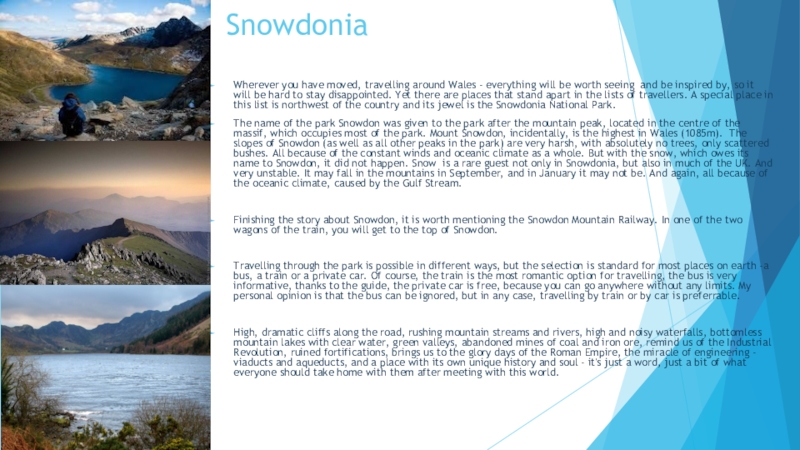
Слайд 7Brecon Beacons
National Park Brecon Beacons created on the territory of
the county of South Wales. Through the reserve through the
four mountain ranges. It is the birthplace of extraordinarily beautiful waterfalls, mountain streams, lakes, wooded valleys and mysterious underground caves.
The only major town in the park - the city of Brecon. It offers a beautiful view of the highest mountains in southern Britain.
Most of the park - moorland, mountain ranges and pastures grassy mountain sheep and ponies.
The park was laid several routes for hiking, equestrian and cycling. Here you can practice climbing, caving, kayaking and fishing of salmon and trout.
Слайд 8Cairngorm
The Cairngorm National Park is one of the most
important natural sights of Scotland. In March 2013 the park
«celebrated» its 10th anniversary. Today, everyone can find something for himself, something for everyone at any time of the year: there are more than more 150 kinds of entertainment, such as skiing and snowboarding in the winter, the mountain bike and the canoe - in the summer, golf, rifle shooting, horseback riding and much more.
To get to the National Park one can take the fastest train from Inverness. It will take you about an hour.
The Cairngorm National Park is home to many endangered species of animals and birds. Here tourists can see many of them, and walk in the beautiful forests, plains, see the picturesque mountain rivers and waterfalls.
Слайд 9Loch Lomond and Trossahz.
Almost two thousand square kilometers of stunning
scenery in Scotland, from the plains of the south to
the high mountains of the north, a lot of lakes, rivers, forests is all the National Park Loch Lomond and Trossahz.
The park has joined 4 different areas: Loch Lomond - the largest freshwater lake in the UK, stretching to a length of 37 km, of which more than 30 are scattered islands; Trossachs, narrow rugged mountain valleys, small lakes and hills.
The national park is the perfect place for the whole family, where everyone will find something for everyone. Loch Lomond Lake is one of the most popular places for windsurfing, and you can ride on water skis or canoes, and inthe yacht club you will learn to sail.For opponents of extreme sports, too, there is something to do - a lot of companies offering cruises on the lake and to nearby islands. You will not be bored - you can go hiking or cycling in one of the two parks (Queen Elizabeth or Argayl) or simply enjoy the stunning views from one of the forty mountain peaks.
A wide variety of plants and animals in different landscapes makes Loch Lomond and The Trossachs fantastic place to observe and study wildlife. One only birds are about 200 species. Cycling is a great way to explore the park. Bicycles can be rented at the Bullock and other communities of the park.
History buffs will not stay on the sidelines due to a variety of historical sites and buildings, castles and monuments. For example, Sterlingtonsky Castle - one of the most important castles in Scotland, associated with many great historic figures (Mary Stuart, William Wallace (Braveheart), Bonnie Prince Charlie).
On both sides of the lake there are several villages. In one of them - Antarex - you can visit the craft shops to see as the famous sheepskin do.
Of course, to get around the whole park in one day is impossible. You can stay in a hotel or in a cottage overlooking the lake.
To get to the park is possible in two ways: on their own, on the train from Glasgow or go on a guided tour to Glasgow or Edinburgh. Although there is a third way - Mountain West (West Highland Way) - for the true lovers of hiking.)) It starts in the outskirts of Glasgow, and just passes through the national park.
